Benin City, Edo, Nigeria
Destroyed 1897

I was born and raised in southern Nigeria in a town called Warri, Bendel State; the capital was Benin City. I always knew about the Benin people and culture as I had family, friends, classmates, and neighbors who were from the Benin tribe. I was even more fascinated by the Benin tradition, kingdom, people, and history while at the Benson Idahosa University in Benin City. As part of my study at, I took a course called Nigerian People and Culture and I was completely stunned by the history I was surrounded by. I had walked past ruins, heard parables, tales, etc. not understanding their history. The Great Benin Walls were a masterpiece that cannot be forgotten, their history can be seen even to this day in its ruins. I hope everyone appreciates the history and ingenuity that went into building a structure we can now appreciate. Tamara U.
The Great Walls of Benin were a series of more than 500 interconnected earth walls (Edo: Lya) in the area around present-day Benin City. They extended for some 16,000 km in all, took an estimated 150 million hours of digging to construct and were perhaps the largest single manmade site on the planet. The date of their construction is unknown, with estimates ranging from the first millennium to the 15th century. The walls were ravaged by the British in 1897 in the “Punitive Expedition” led by Rear-Admiral Harry Rawson in retaliation for the so-called “Benin Massacre” (a surprise attack on British forces attempting to capture Benin City.) Much of the art looted at the time is still on display at the British Museum and in other museums outside of Nigeria. Calls for the restitution of the Benin Bronzes are meeting with increasingly success. Scattered remains of the Walls exist today, although many are being torn down to make space for real estate development
The first version of this painting was based on an uncredited image that I found on the internet several times claiming to be an image of the walls, but it turned out that this was in fact an image of the Round City of Bagdad, so I fear I inadvertently contributed to the spread of misinformation with my first version. This version is based on the only credible image I have been able to find — based on a drawing of Benin City made by a British Officer in 1897.
No. 102